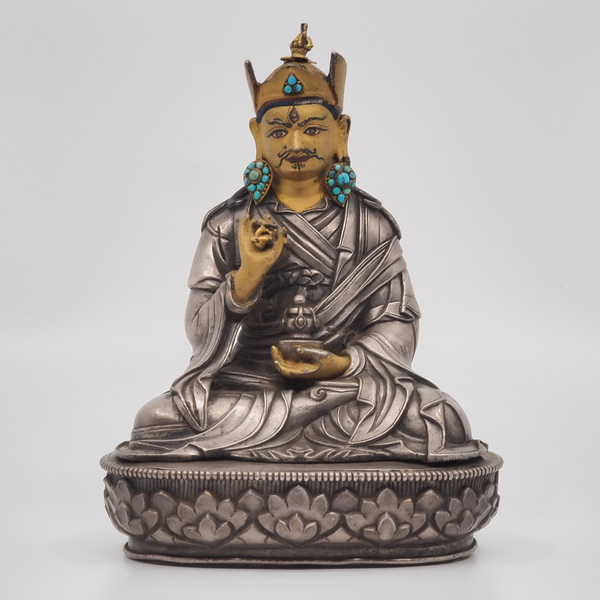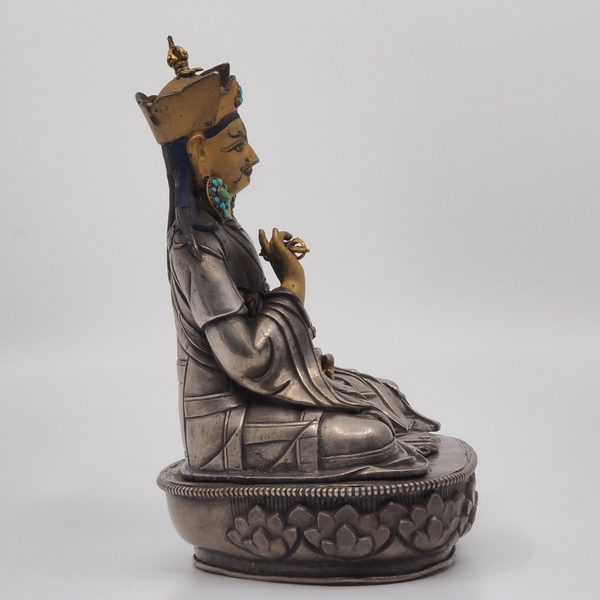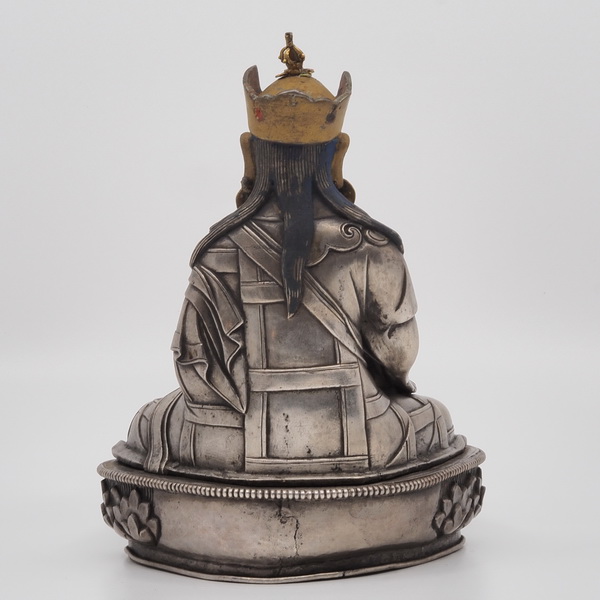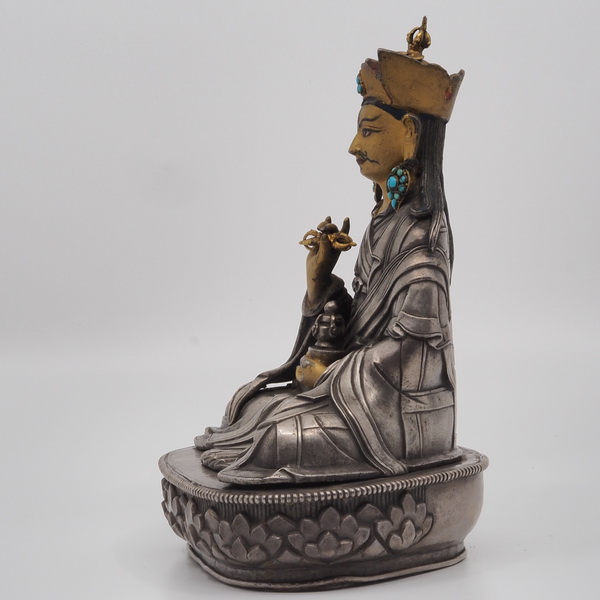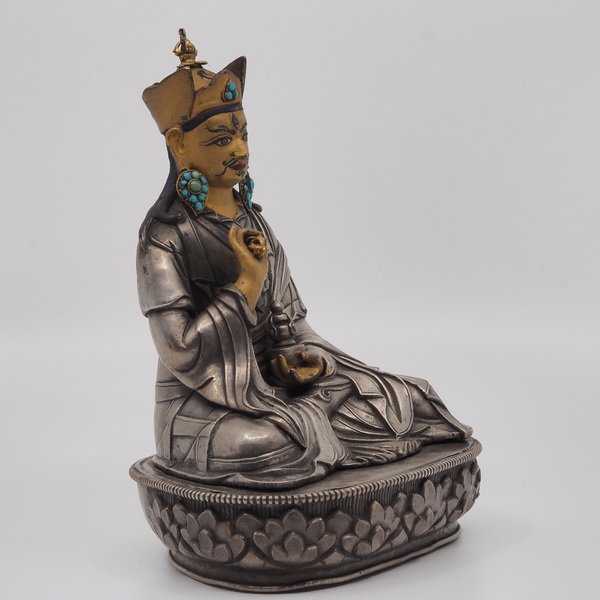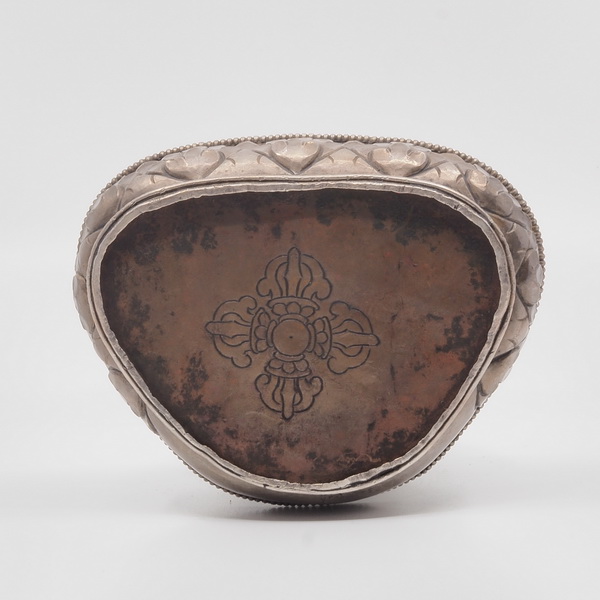ABS 301
Code: ABS 301
Country: Bhutan
Style:
Date: 1750 - 1800
Dimensions in cm WxHxD: 12.3 x 16.5 x 10.3
Materials: Silver
bottom of the lotus pedestal is sealed with a sheet of copper decorated with the visvavajra emblem.
Padmasambhava “born from a lotus” (Tib.: Padma ’byung gnas) is seated in the diamond attitude (vajraparyanka) on the skin of an antelope placed upon a double lotus pedestal. He holds in the right hand a five-pronged diamond sceptre (vajra), and in the left hand, resting in the lap, a “full vase” (purnakalasa). The separater cast ceremonial ritual staff (khatvanga) originally leaning against the left shoulder is lost. Padmasambhava is clad with a voluminous array of monastic garments (tricivara) with the borders decorated with floral patterns and wears the typical cap decorated with the sun-in-moon crescent emblem, and surmounted by a half-vajra.
Padmasambhaya was a famous Indian tantric adept who lived in the eight century and who, together with Santaraksita and Kamalasila, was instrumental in the propagation of Buddhism in Tibet. The rNying ma school or “ancient translation school” is based on the teachings of the Padmasambhava, who was later deified of whom they worship eight different manifestations.
According to the design of the lotus pedestal, this image originates from Bhutan - a traditional stronghold of the rNying ma school. This image is of better quality than any of the images of Padmasambhava included in the catalogue of the exhibition The Dragon’s Gift: The Sacred Arts of Bhutan.
(Formerly von Schroeder Collection)
Padmasambhava
Padmasambhava (also Padmakara or Padma Raja; earlier - Saroruha Vajra or simply Saroruha) (Pinyin: Lian Hua Sheng Shang Shi; Tib: Pema Jungne, Wylie: padma 'byung gnas), in Sanskrit meaning "lotus-born", is said to have brought Tantric Buddhism to Tibet in the 8th century. In Bhutan and Tibet he is better known as Guru Rinpoche ("Precious Master") or Lopon Rinpoche, where followers of the Nyingma school regard him as the second Buddha.
Life and teachings
According to tradition, Padmasambhava was incarnated as an eight-year-old child appearing in a lotus blossom floating in Lake Dhanakosha, in the kingdom of Uddiyana, traditionally identified with the Swat Valley in present-day Pakistan. His special nature was recognized by the local king who married him to one of his daughters, Mandarava. She and Padmasambhava's other main consort, Yeshe Tsogyal, developed into realised practitioners. Many thangkas and paintings show Padmasambhava in between them.
Padmasambhava's ability to memorize and comprehend esoteric texts in a single hearing established his reputation as a master above all others. Knowing that the life force of the wife and son of evil minister was about to end, he constructed an accident which resulted in their death. As a result, Padmasambhava was banished from the court and exiled in a charnel ground. Transiting various heavens and hells, he developed the power to transcend the cycle of birth and death, accomplishing the so-called great transference, otherwise known as Nirvana.
His fame became known to Trisong Detsen, the 38th king of Tibet (742–797), whose kingdom was beset by evil mountain deities. The king invited Padmasambhava to Tibet where he used his tantric powers to subdue the evil deities he encountered along the way, eventually receiving the Emperor's wife, identified with the dakini Yeshe Tsogyal, as a consort. This was in accordance with the tantric principle of not eliminating negative forces but redirecting them to fuel the journey toward spiritual awakening. In Tibet he founded the first monastery in the country, Samye Gompa, initiated the first monks, and introduced the people to the practice of Tantric Buddhism.
In Bhutan he is associated with the famous Taktshang or "Tiger's Nest" monastery built on a sheer cliff wall about 500m above the floor of Paro valley. He flew there from Tibet on the back of Yeshe Tsogyal, whom he transformed into a flying tigress for the purpose of the trip. Later he travelled to Bumthang district to subdue a powerful deity offended by a local king. Padmasambhava's body imprint can be found in the wall of a cave at nearby Kurje Lhakhang temple.
Padmasambhava also hid a number of religious treasures (termas) in lakes, caves, fields and forests of the Himalayan region to be found and interpreted by future tertöns or spiritual treasure-finders. According to Tibetan tradition, the Bardo Thodol (commonly referred to as the Tibetan Book of the Dead) was among these hidden treasures, subsequently discovered by a Tibetan terton, Karma Lingpa.
Iconography
The katvanga, a danda with three severed heads denoting liberation from the three worlds or triloka, crowned by a trishula and dressed with a sash of the Himalayan Rainbow or Five Pure Lights of the Mahabhuta is a particular divine attribute of Padmasambhava and endemic to his iconographic representation. The katvanga is also emblematic of Padmasambhava when depicted as an accoutrement of his divine consorts, Mandarava and Yeshe Tsogyal and according to the Twilight Language is representative of Yab-Yum in these examples.
Manifestations
Padmasambhava is said to have taken eight forms or manifestations (Tib. Guru Tsen Gye) representing different aspects of his being - wrath, pacification, etc.:
* 1. Guru Orgyen Dorje Chang
* 2. Guru Shakya Senge
* 3. Guru Pema Gyalpo
* 4. Guru Padmasambhava
* 5. Guru Loden Chokse
* 6. Guru Nyima Ozer
* 7. Guru Dorje Drolo
* 8. Guru Senge Dradog
The Vajra Guru mantra
The Vajra Guru (Padmasambhava) mantra is one of the two most esteemed mantras in Tibet along with the famous mantra of Avalokiteshvara (Chenresig): Om Mani Padme Hum. Like most mantras in Tibet it is in Sanskrit, though pronounced somewhat differently in Tibetan.
It is: Om Ah Hum Vajra Guru Padma Siddhi Hum, which is pronounced by Tibetans as Om Ah Hum Benza Guru Pema Siddhi Hum'. It is considered to be a powerful healing mantra and brings the blessings of the wisdom mind and the compassion and noble qualities of Guru Rinpoche (Padmasambhava) and all the buddhas.
Bartholomew, Terese Tse and Johnston, John, 2008. The Dragon’s Gift: The Sacred Arts of Bhutan, [catalogue of the exhibition held at Asia House Gallery, New York, Februar 25, 2008 — May 23, 2008]. Chicago: Serindia Publications. Pp. 275—277, pls. 57—58
Béguin, Gilles, 2013. Art sacré du Tibet – Collection Alain Bordier, [catalogue of the exhibition held at the Fondation Pierre Bergé – Yves Saint Laurent; 14 mars au 21 juillet 2013]. Paris: Fondation Pierre Bergé – Yves Saint Laurent. Editions Findakli. Pp. 26, 180–181, 189
Cornu, Philippe , 2001. Dictionnaire Encyclopédique du Bouddhisme. Seuil.
Cornu, Philippe, 2002. Padmasambhava, les Nyingmapa et leur influence sur le Ve Dalaï Lama. Rituels tibétains : visions secrètes du Ve Dalaï Lama.. Paris : Réunion des musées nationaux. Pp. 32–37
David-Néel, Alexandra und Yongden, Albert Arthur , 1978. La vie surhumaine de Guésar de Ling : le héros thibétain : racontée par les bardes de son pays. . Monaco: Ed. du Rocher.
Douglas, Kenneth und Bays, Gwendolyn , 2003. Padmasambhava. In: Das Oxford-Lexikon der Weltreligionen.. Frankfurt am Main: Fischer. Pp. 749-750
Essen, Gerd-Wolfgang and Thiago, Tsering Tashi, 1991. . Padmasambhava: Leben und Wundertaten des grossen tantrischen Meisters im Spiegel der tibetischen Bildkunst.. Köln: DuMont Verlag.
Sèngué, Tcheuky, 2002. Petite Encyclopédie des Divinités et symboles du Bouddhisme Tibétain. Editions Claire Lumiere . Pp. 280-287
Ye shes mtsho rgyal , 1978. Padma bka’i thang. Tarthang Tulku (transl.). 1978. The Life and Liberation of Padmasambhava, 2 Parts. . Berkeley: Dharma Publishing.

